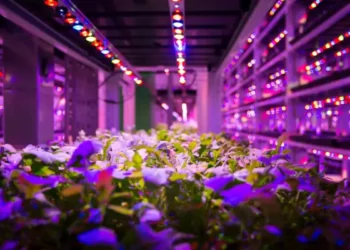Climate change is forcing agriculture to adapt faster than ever before. Rising temperatures, erratic rainfall, and increased atmospheric CO₂ levels are disrupting traditional cultivation methods. For controlled-environment agriculture, whether in greenhouses, vertical farms, or growth chambers, this means rethinking every element of the setup, especially lighting. LED grow lights go beyond just a substitute for sunlight; they’re a primary growth input, directly impacting plant morphology, yield, and energy efficiency. As climate variables become harder to control, the future of high-quality horticulture lights will hinge on their adaptability, consistency, and spectral precision.
Climate Stress Is Redefining Lighting Priorities
Reduced sunlight, particularly in northern climates and urban environments, is making artificial lighting indispensable. But it’s not just about adding light—it’s about delivering the right kind of light at the right time. Crops grown in climate-stressed environments, such as greenhouses during heatwaves or low-light winters, require LED luminaires that can adjust spectra in response to plant stress.
Many studies now show that plants under heat stress benefit from enhanced blue and far-red light ratios, which support photomorphogenic resilience. This means growers must select fixtures capable of spectrum modulation, something traditional lighting systems can’t offer.
Controlled Environment Agriculture (CEA) Is Expanding Rapidly
With unpredictable outdoor conditions, many growers are transitioning to greenhouses, vertical farms, and plant factories. CEA environments rely heavily on lighting systems that simulate natural conditions without introducing additional stress. LED grow lights have become foundational in these systems. Unlike legacy solutions (e.g., HPS lamps), LEDs produce low radiant heat, minimizing the risk of heat stress in closed environments. Furthermore, their ability to focus light on canopy levels ensures more efficient photosynthetic activity.
In vertical farms where layering crops reduces natural light penetration, high-quality horticulture lights ensure uniform light distribution, thereby reducing crop variability and improving yield predictability.
Sustainability Pressures Are Driving R&D in Light Efficiency
Energy consumption is a major operational concern, especially for facilities running lights up to 16–18 hours a day. As countries introduce carbon regulations and energy tariffs in response to climate change, the efficiency of horticultural lighting solutions is becoming a critical factor in system design.
Valoya’s LED luminaires are emerging as a reliable substitute for traditional fluorescent fixtures in controlled environments. Designed specifically for research and cultivation settings, these luminaires offer a perfect mix of high photon efficacy and long-term energy savings.
Adaptive Light Recipes for Specific Climate Conditions
As climate patterns shift, so do plant needs. Crops growing in regions with high humidity or increased nighttime temperatures may require adjusted light spectra to reduce disease risk or stimulate key growth phases. Customizable LED grow lights make this possible through crop-specific “light recipes.”
Light recipes developed for lettuce in Nordic climates differ from those used for tomatoes in high-heat zones. Researchers can program LEDs to shift spectra at different growth stages, boosting vegetative growth with red light early on, then switching to blue to trigger flowering or secondary metabolite production.
Integration with Smart Systems Is Becoming the Norm
Climate variability increases the value of responsive systems. Smart integration of LED grow lights with climate monitoring tools and plant sensors allows automated real-time lighting adjustments based on PAR values, DLI targets, and crop feedback.
In multi-zone greenhouses, growers can now zone-control horticultural lighting solutions to address microclimate variations. A single facility might run different spectra or light durations in adjacent zones based on cultivar and environmental inputs, maximizing productivity and reducing input waste.
As climate change impacts agriculture, LED crop lighting systems are evolving fast. Manufacturers like Valoya are helping researchers and growers adapt with consistent spectra, flexible designs, and proven performance. Choosing high-quality horticulture lights is now key to ensuring reliable crop production in an uncertain climate.














